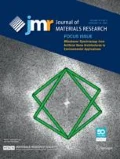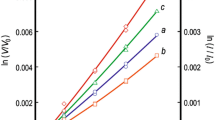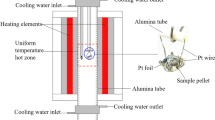Abstract
The system GeO2–TiO2 was studied experimentally at high pressure and temperature to measure the miscibility of the two components and to test its applicability as a temperature sensor in high-pressure experiments. Significant solubility between the two end-members was found, with two coexisting solid solutions at high pressure exhibiting mutual solubility that increases with temperature along a solvus. The two solid solution compositions at the solvus can be distinguished readily by X-ray diffraction. At higher temperatures, a complete solid solution exists between the two end-members. The complete solution occurs above a critical line in P–T space (a critical point at each pressure). The critical point is located near 1630 °C and mole fraction \({X_{{\rm{Ti}}{{\rm{O}}_{\rm{2}}}}} = 0.57\) at 6.6 GPa and changes by 60 ± 5° per GPa in the region from 4 to 7 GPa. A model for the shape of the solvus is developed using X-ray diffraction data points from a series of quench experiments and an in situ experiment, and the model is used to estimate the thermal gradients in a Kawai-type multianvil assembly.







Similar content being viewed by others
References
Y.F. Ren, Y.W. Fei, J.S. Yang, and W.J. Bai: SiO2 solubility in rutile at high temperature and high pressure. J. Earth Sci. 2, 274 (2009).
A. Gullikson, K. Leinenweber, E. Stoyanov, H. Zhang, and A-S. Malik: High pressure investigation in the system SiO2–GeO2: Mutual solubility of Si and Ge in quartz, coesite, and rutile-type phases. J. Am. Ceram. Soc. 98, 982 (2015).
E. Kulik, N. Nishiyama, A. Masuno, Y. Zubavichus, V. Murzin, E. Khramov, A. Yamada, H. Ohfuji, H.C. Wille, T. Irifune, and T. Katsura: A complete solid solution with rutile-type structure in SiO2–GeO2 system at 12 GPa and 1600 °C. J. Am. Ceram. Soc. 98, 4111 (2015).
K. Leinenweber, A. Gullikson, E. Stoyanov, and A-S. Malik: Saturation curve of SiO2 component in rutile-type GeO2: A recoverable high-temperature pressure standard from 3 GPa to 10 GPa. J. Solid State Chem. 229, 10 (2015).
F. Schilling and B. Wunder: Temperature distribution in piston-cylinder assemblies: Numerical simulations and laboratory experiments. Eur. J. Mineral. 16, 7 (2004).
E. Watson, D. Wark, J. Price, and J. Van Orman: Mapping the thermal structure of solid-media pressure assemblies. Contrib. Mineral. Petrol. 142, 640 (2002).
W. van Westrenen, J.A. Van Orman, H. Watson, Y. Fei, and E.B. Watson: Assessment of temperature gradients in multianvil assemblies using spinel layer growth kinetics. Geochem., Geophys., Geosyst. 4, 1036 (2003).
J. Hernlund, K. Leinenweber, D. Locke, and J.A. Tyburczy: A numerical model for steady-state temperature distributions in solid-medium high-pressure cell assemblies. Am. Mineral. 91, 295 (2006).
J.F. Sarver: Polymorphism and subsolidus equilibria in the system GeO2–TiO2. Am. J. Sci. 259, 709 (1961).
E. Stoyanov, K. Leinenweber, T.L. Groy, and A-S. Malik: Ge0.57Ti0.43O2: A new high-pressure material with rutile-type crystal structure. Acta Crystallogr., Sect. E: Crystallogr. Commun. 74, 1010 (2018).
A.P. Douce: Thermodynamics of the Earth and Planets, 1st ed. (Cambridge University Press, Cambridge, England, 2011); p. 279, 355, 359.
E. Stoyanov, U. Haussermann, and K. Leinenweber: Large-volume multianvil cells designed for chemical synthesis at high pressures. High Pressure Res. 30, 175 (2010).
M.N. Khan and A.E. Mohamed-Osman: Infrared and X-ray diffraction studies of TiO2–GeO2 glasses. J. Mater. Sci. Lett. 5, 965 (1986).
D.L. Decker: High-pressure equation of state for NaCl, KCl, and CsCl. J. Appl. Phys. 42, 3239 (1971).
J. Haines, J.M. Léger, C. Chateau, and A.S. Pereira: Structural evolution of rutile-type and CaCl2-type germanium dioxide at high pressure. Phys. Chem. Miner. 27, 575 (2000).
L. Gerward and J.S. Olsen: Post-rutile high-pressure phases in TiO2. J. Appl. Crystallogr. 30, 259 (1997).
Acknowledgments
Funding for this project was provided by Hyperion Materials and Technologies. Use of the COMPRES Cell Assembly Project was supported by COMPRES under NSF Cooperative Agreement EAR 1661511. Portions of this work were performed at GeoSoilEnviroCARS (GSECARS) (Sector 13), Advanced Photon Source (APS), and Argonne National Laboratory. GeoSoilEnviroCARS is supported by the National Science Foundation—Earth Sciences (EAR-1128799) and Department of Energy—Geosciences (DE-FG02-94ER14466). This research used resources of the Advanced Photon Source, a U.S. Department of Energy (DOE) Office of Science User Facility operated for the DOE Office of Science by Argonne National Laboratory under Contract no. DE-AC02-06CH11357. We would like to thank the two reviewers for their constructive feedback. We also thank Camille Mayberry for assistance with experiments at ASU, Devin Keating at ASU for his help with taking optical images of the synthesized samples, and Yanbin Wang and Tony Yu at GSECARS for beamline support.
Author information
Authors and Affiliations
Corresponding author
Rights and permissions
About this article
Cite this article
Leinenweber, K., Stoyanov, E. & Malik, AS. Immiscibility between two rutile phases in the GeO2–TiO2 system and application as a temperature sensor in high-pressure experiments. Journal of Materials Research 34, 3368–3376 (2019). https://doi.org/10.1557/jmr.2019.253
Received:
Accepted:
Published:
Issue Date:
DOI: https://doi.org/10.1557/jmr.2019.253




